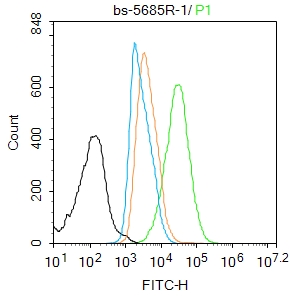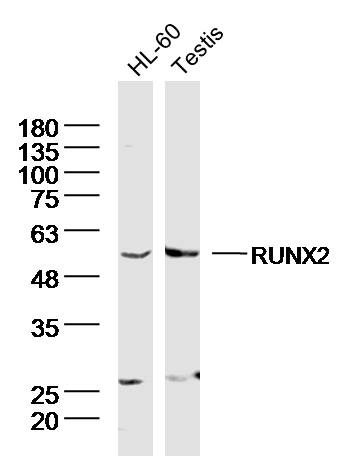
HL-60 cells were fixed with 4% PFA for 10min at room temperature,permeabilized with 90% ice-cold methanol for 20 min at -20℃, and incubated in 5% BSA blocking buffer for 30 min at room temperature. Cells were then stained with phospho-RUNX2 (Ser451) Polyclonal Antibody(bs-5685R)at 1:100 dilution in blocking buffer and incubated for 30 min at room temperature, washed twice with 2%BSA in PBS, followed by secondary antibody incubation for 40 min at room temperature. Acquisitions of 20,000 events were performed. Cells stained with primary antibody (green), and isotype control (orange).
phospho-RUNX2 (Ser451) Polyclonal Antibody
BS-5685R
Overview
- SupplierBioss Antibodies
- Product NameRUNX2(Ser451) Polyclonal Antibody
- Delivery Days Customer16
- ApplicationsFlow Cytometry, Western Blot, ELISA
- Applications SupplierWB(1:300-5000), ELISA(1:500-1000), FCM(1:20-100)
- CertificationResearch Use Only
- ClonalityPolyclonal
- Concentration1 ug/ul
- ConjugateUnconjugated
- Gene ID860
- Target nameRUNX2
- Target descriptionRUNX family transcription factor 2
- Target synonymsacute myeloid leukemia 3 protein; AML3; CBFA1; CBF-alpha-1; CCD; CCD1; CLCD; core-binding factor, runt domain, alpha subunit 1; oncogene AML-3; OSF2; OSF-2; osteoblast-specific transcription factor 2; PEA2aA; PEA2-alpha A; PEBP2aA; PEBP2-alpha A; polyomavirus enhancer-binding protein 2 alpha A subunit; runt related transcription factor 2; runt-related transcription factor 2; SL3/AKV core-binding factor alpha A subunit; SL3-3 enhancer factor 1 alpha A subunit
- HostRabbit
- IsotypeIgG
- Protein IDQ13950
- Protein NameRunt-related transcription factor 2
- Storage Instruction-20°C
- UNSPSC12352203
References
- Characterization of CADD522, a small molecule that inhibits RUNX2-DNA binding and exhibits antitumor activity. Kim MS et al., 2017 Sep 19, OncotargetRead more
- Human Amnion-Derived Mesenchymal Stem Cells Protect Human Bone Marrow Mesenchymal Stem Cells against Oxidative Stress-Mediated Dysfunction via ERK1/2 MAPK Signaling. Wang Y et al., 2016 Mar, Mol CellsRead more






